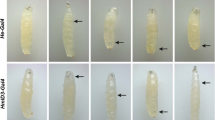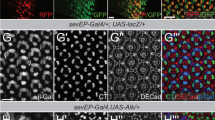Abstract
The Mixed Lineage Leukemia (MLL) gene is involved in lymphoblastic and myeloid leukemia through chromosome translocations leading to fusion of MLL to partner genes, or through internal MLL rearrangements. MLL is the mammalian counterpart of the Drosophila trithorax (trx) gene, involved in maintaining active gene expression states. We have used transgenic Drosophila to assess the molecular targets and cellular processes affected by MLL and two of its leukemic fusion proteins. We find that whereas expression of normal human MLL in flies does not result in phenotypic alterations, overexpressing the human MLL-AF9 and MLL-AF4 proteins causes larval to pupal lethality, which interestingly resembles the phenotypes displayed by certain Drosophila trx mutant alleles. MLL-AF9 and MLL-AF4 transgenic flies exhibit antagonistic alterations in cell cycle progression. Additionally, flies expressing MLL-AF9 display impairment in higher order chromatin integrity, evidenced in decondensation of mitotic figures. The effects of MLL fusion proteins in Drosophila suggest that alteration of chromatin structure by MLL fusion proteins may contribute to the lethal phenotype. Our results indicate that the mode(s) of action of MLL-AF9 in Drosophila varies from that of MLL-AF4. Taken together, the expression of MLL fusion proteins in Drosophila provides a new and powerful system to reveal and characterize biological activities associated with MLL fusion proteins.
This is a preview of subscription content, access via your institution
Access options
Subscribe to this journal
Receive 50 print issues and online access
$259.00 per year
only $5.18 per issue
Buy this article
- Purchase on Springer Link
- Instant access to full article PDF
Prices may be subject to local taxes which are calculated during checkout






Similar content being viewed by others
References
Asha H, Nagy I, Kovacs G, Stetson D, Ando I and Dearolf CR . (2003). Genetics, 163, 203–215.
Ayton PM and Cleary ML . (2001). Oncogene, 20, 5695–5707.
Ayton PM and Cleary ML . (2003). Genes Dev., 17, 2298–2307.
Bernardoni R, Vivancos V and Giangrande A . (1997). Dev. Biol., 191, 118–130.
Brand AH and Perrimon N . (1993). Development, 118, 401–415.
Breen TR . (1999). Genetics, 152, 319–344.
Breen TR and Harte PJ . (1993). Development, 117, 119–134.
Canaani E, Nowel PC and Croce CM . (1995). Adv. Cancer Res., 66, 213–233.
Collins E, Appert A, Ariza-McNaughton L, Pannell R, Yamada Y and Rabbitts TH . (2002). Mol. Cell. Biol., 22, 7313–7324.
Collins E and Rabbitts T . (2002). Trends Mol. Med., 8, 436.
Corral J, Lavenir I, Impey H, Warren A, Forster A, Larson TA, Bell S, McKenzie ANJ, King G and Rabbitts TH . (1996). Cell, 85, 853–861.
Cronmiller C and Cummings CA . (1993). Mech. Dev., 42, 159–169.
Fair K, Anderson M, Bulanova E, Mi H, Tropschug M and Diaz MO . (2001). Mol. Cell. Biol., 10, 3589–3597.
Forster A, Pannell R, Drynan LF, McCormack M, Collins EC, Daser A and Rabbitts TH . (2003). Cancer Cell, 3, 449–458.
Gu Y, Nakamura T, Alder H, Prasad R, Canaani O, Cimino G, Croce CM and Canaani E . (1992). Cell, 71, 701–708.
Hanson RD, Hess JL, Yu BD, Ernst P, van Lohuizen M, Berns A, van der Lugt NMT, Shashikant CS, Ruddle FH, Seto M and Korsmeyer SJ . (1999). Proc. Natl. Acad. Sci. USA, 96, 14372–14377.
Hendrich B and Bird A . (1998). Mol. Cell. Biol., 18, 6538–6547.
Hidalgo A, Urban J and Brand AH . (1995). Development, 121, 3703–3712.
Isnard P, Core N, Naquet P and Djabali M . (2000). Blood, 96, 705–710.
Ito K, Awano W, Suzuki K, Hiromi Y and Yamamoto D . (1997). Development, 124, 761–771.
Kimbrell DA, Hice C, Bolduc C, Kleinhesselink K and Beckingham K . (2002). Genesis, 34, 23–28.
Krause SA, Loupart M, Vass S, Schoenfelder S, Harrison S and Heck MMS . (2001). Mol. Cell. Biol., 21, 5156–5168.
Lebestky T, Chang T, Hartenstein V and Banerjee U . (2000). Science, 288, 146–149.
Loupart M, Krause SA and Heck MMS . (2000). Curr. Biol., 10, 1547–1556.
Ma Q, Alder H, Nelson KK, Chatterjee D, Gu Y, Nakamura T, Canaani E, Croce CM, Siracusa LD and Buchberg AM . (1993). Proc. Natl. Acad. Sci. USA, 90, 6350–6354.
Milne TA, Briggs SD, Brock HW, Martin ME, Gibbs D, Allis CD and Hess JL . (2002). Mol. Cell, 10, 1107–1117.
Murray MA, Fessler LI and Palka J . (1995). Dev. Biol., 168, 150–165.
Nakamura T, Mori T, Tada S, Krajewski W, Rozovskaia T, Wassell R, Dubois G, Mazo A, Croce CM and Canaani E . (2002). Mol. Cell, 10, 1119–1128.
Pflumm MF and Botchan MR . (2001). Development, 128, 1697–1707.
Prasad R, Yano T, Sorio C, Nakamura T, Rallapalli R, Gu Y, Leshkowitz D, Croce CM and Canaani E . (1995). Proc. Natl. Acad. Sci. USA, 92, 12160–12164.
Rozovskaia T, Feinstein E, Mor O, Foa R, Blechman J, Nakamura T, Croce CM, Cimino G and Canaani E . (2001). Oncogene, 20, 874–878.
Slany RK, Lavau C and Cleary ML . (1998). Mol. Cell. Biol., 18, 122–129.
Tkachuk DC, Kohler S and Cleary ML . (1992). Cell, 71, 691–700.
van Lohuizen M . (1999). Curr. Opin. Genet. Dev., 9, 355–361.
Wilder EL and Perrimon N . (1995). Development, 121, 477–488.
Wodarz A, Hinz U, Engelbert M and Knust E . (1995). Cell, 82, 67–76.
Yano T, Nakamura T, Blechman J, Sorio C, Dang CV, Geiger B and Canaani E . (1997). Proc. Natl. Acad. Sci. USA, 94, 7286–7291.
Yu BD, Hess JL, Horning SE, Brown GA and Korsmeyer SJ . (1995). Nature, 378, 505–508.
Zeleznik-Le NJ, Harden AM and Rowley JD . (1994). Proc. Natl. Acad. Sci. USA, 91, 10610–10614.
Acknowledgements
We thank Isolde Riede for fruitful discussions and to Leonie Ringrose, Joep Muijrers, and Dirk Lankenau for critical reading of the manuscript. This project was supported by a grant to RP and EC from the German-Israeli Cooperative Project in Cancer Research, by grants to RP from the Deutsche Forschungsgemeinschaft and the Fonds der Chemischen Industrie, and by a grant to EC from the Israeli Academy of Science. IMC was further supported by a National Science Foundation Graduate Fellowship.
Author information
Authors and Affiliations
Corresponding author
Rights and permissions
About this article
Cite this article
Muyrers-Chen, I., Rozovskaia, T., Lee, N. et al. Expression of leukemic MLL fusion proteins in Drosophila affects cell cycle control and chromosome morphology. Oncogene 23, 8639–8648 (2004). https://doi.org/10.1038/sj.onc.1207904
Received:
Revised:
Accepted:
Published:
Issue Date:
DOI: https://doi.org/10.1038/sj.onc.1207904
Keywords
This article is cited by
-
COMPASS and SWI/SNF complexes in development and disease
Nature Reviews Genetics (2021)
-
The ribonuclease Dis3 is an essential regulator of the developmental transcriptome
BMC Genomics (2012)
-
Trithorax group proteins: switching genes on and keeping them active
Nature Reviews Molecular Cell Biology (2011)
-
Immunobiological diversity in infant acute lymphoblastic leukemia is related to the occurrence and type of MLL gene rearrangement
Leukemia (2007)
-
Cytogenetic harvesting of commonly used tumor cell lines
Nature Protocols (2007)



